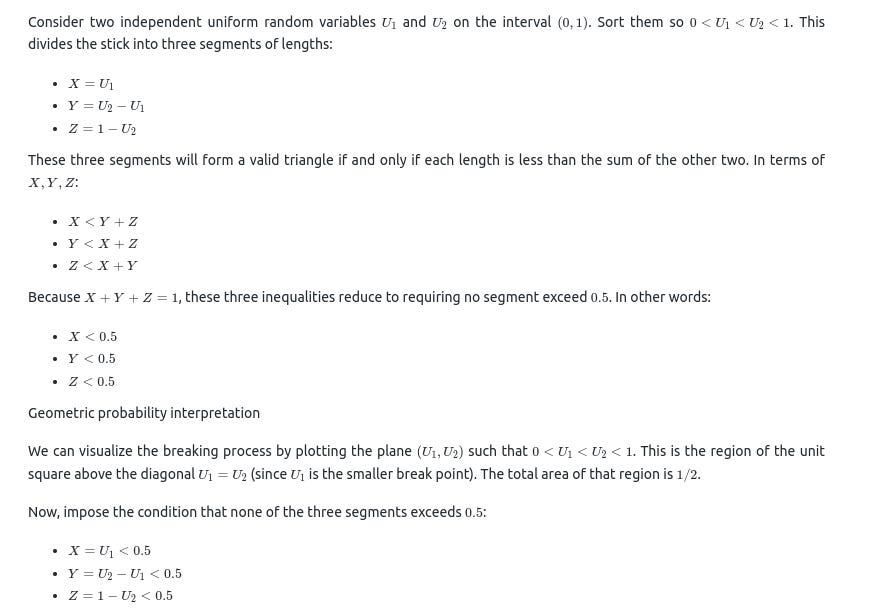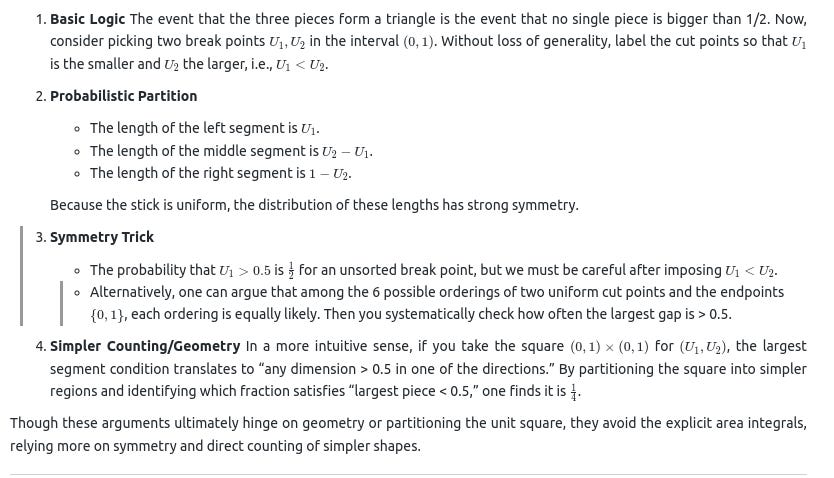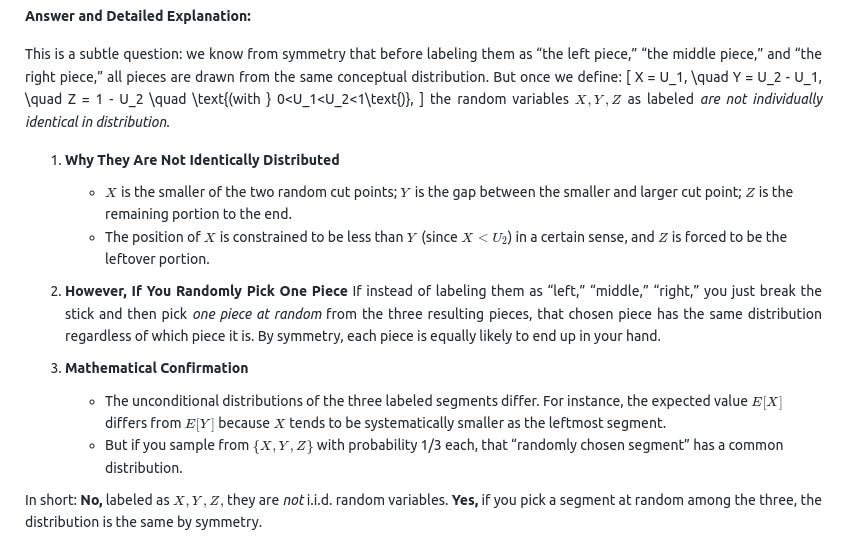ML Interview Q Series: Geometric Probability: Forming a Triangle from Random Stick Breaks
📚 Browse the full ML Interview series here.
This problem was asked by Google.
Assume you take have a stick of length 1 and you break it uniformly at random into three parts. What is the probability that the three parts form a triangle?
Approach with the random break representation
Geometric probability interpretation
Practical simulation hint
One might confirm this probability via simulation in a language such as Python:
import numpy as np
n_samples = 10_000_000
break_points = np.sort(np.random.rand(n_samples, 2), axis=1)
X = break_points[:, 0]
Y = break_points[:, 1] - break_points[:, 0]
Z = 1 - break_points[:, 1]
valid_triangles = (X + Y > Z) & (X + Z > Y) & (Y + Z > X)
estimated_probability = np.mean(valid_triangles)
print(estimated_probability)
This code will consistently give an approximation near 0.25.
Possible follow-up questions and detailed answers
How could we generalize this idea to sticks broken into more than three parts?
One extends the triangle inequality constraints to higher-dimensional simplexes. For four segments, the condition to form a tetrahedron in some geometric sense is not analogous to a simple triangle condition in 1D, but one could ask similar inequalities about side lengths if we interpret them differently. In practice, for nn breaks, the segments are drawn from a Dirichlet distribution (special case is all parameters = 1). One would need to characterize the geometric constraints for forming the desired shape (e.g., a 1D polygon interpretation of “successive segments can fold into a closed loop”).
Is there an intuitive explanation of why the probability is 1/4?
It boils down to avoiding any segment being over half of the total. If you imagine picking the first break point, you want neither side of that point to be too large. Then the second point must be placed so that the middle piece remains small enough. These constraints carve out a region in the allowable space that takes up exactly 1/4 of the total ways two random cuts can occur.
What if the breaks are not uniform?
The uniform assumption is critical for the geometric interpretation. With non-uniform breaks, one would have a different probability distribution for (U1,U2)(U1,U2). For example, if you choose one break point using some bias or you condition on length constraints, the final probability changes. You can still rely on the same triangle inequality criteria but would have to compute the probability with respect to the new distribution on break points. That often involves integrating over a more complicated density function rather than uniform areas.
Why does sorting the break points matter?
1) Can we solve this problem using direct integration instead of a geometric area argument?
Answer and Detailed Explanation:
Absolutely. While the geometric approach (viewing the problem as finding the area of a region in the unit square) is often the quickest route, you can also solve the problem by setting up and evaluating integrals that directly encode the “triangle-forming” inequalities.
2) What if we break the stick sequentially: first one cut, then pick one of the two resulting pieces at random to cut again?
Answer and Detailed Explanation:
This scenario changes the distribution of the final three segments because the second break is not necessarily anywhere along the original stick—it only happens on one of the two initial pieces, chosen at random.
Result It turns out that the probability for this sequential-breaking approach is different (and it is slightly larger than 1/41/4). A more detailed integral calculation or a simulation approach will yield the numerical answer (approximately 0.25+something small0.25+something small). Indeed, simulation is often easier:
import numpy as np
n_samples = 10_000_000
first_break = np.random.rand(n_samples)
# Decide which segment to break again
pick_first_segment = np.random.rand(n_samples) < 0.5
# For those who pick the first segment
second_break_1 = np.random.rand(n_samples) * first_break
# final segments: second_break_1, first_break - second_break_1, 1 - first_break
# For those who pick the second segment
second_break_2 = np.random.rand(n_samples) * (1 - first_break)
# final segments: first_break, second_break_2, (1 - first_break) - second_break_2
# Combine cases, check triangle conditions, average, etc.
By carefully tracking the lengths in each scenario, you can compute the fraction that forms a valid triangle. This yields a probability strictly greater than 1/41/4 but less than 1/21/2. Exact solutions involve piecewise integrals but typically simulation suffices to confirm the difference.
3) What is the distribution of the largest piece among the three segments?
When two points cut a unit stick at random (simultaneously chosen, then sorted), we get three segments (X,Y,Z). A natural question is: Which piece is typically the largest, and how is its length distributed?
4) Could there be a purely combinatorial or symmetry-based argument for the probability of 1/4?
Answer and Detailed Explanation:
Yes, you can use symmetry and elementary probability steps without explicitly computing areas or integrals, though it is still somewhat geometric in nature:
5) How does changing the stick length from 1 to some other length LL affect the probability?
Answer and Detailed Explanation:
6) What if we specifically want the probability of forming an acute triangle?
7) If a triangle does form, what is the expected perimeter of that triangle?
8) Could we form a right triangle from such random breaks, and what is the probability?
9) Are the side lengths (X,Y,Z) themselves identically distributed as random variables?
10) Could we extend the reasoning to find the probability distribution of angles in the triangle that does form?
Summary
The classic broken stick problem where two uniform cuts are made on a stick of length 1 produces three random segments. The probability that these segments can form a triangle is 1/4. We arrived at that result through:
Geometric Region Argument: Identifying the portion of the unit square (U1,U2) in which no segment exceeds half the total.
Direct Integration: Setting up definite integrals that yield 0.25.
Symmetry Arguments: Reasoning that the triangle condition (no side > 0.5) is only satisfied in one-fourth of the cases.
Beyond the core result, the above follow-up questions highlight a variety of deeper explorations: sequential breaking vs. simultaneous breaking, distributions of the largest piece, forming acute vs. right triangles, and examining angle distributions. Each extension demonstrates both the richness of the core problem and how subtle changes in assumptions can alter the outcome.















